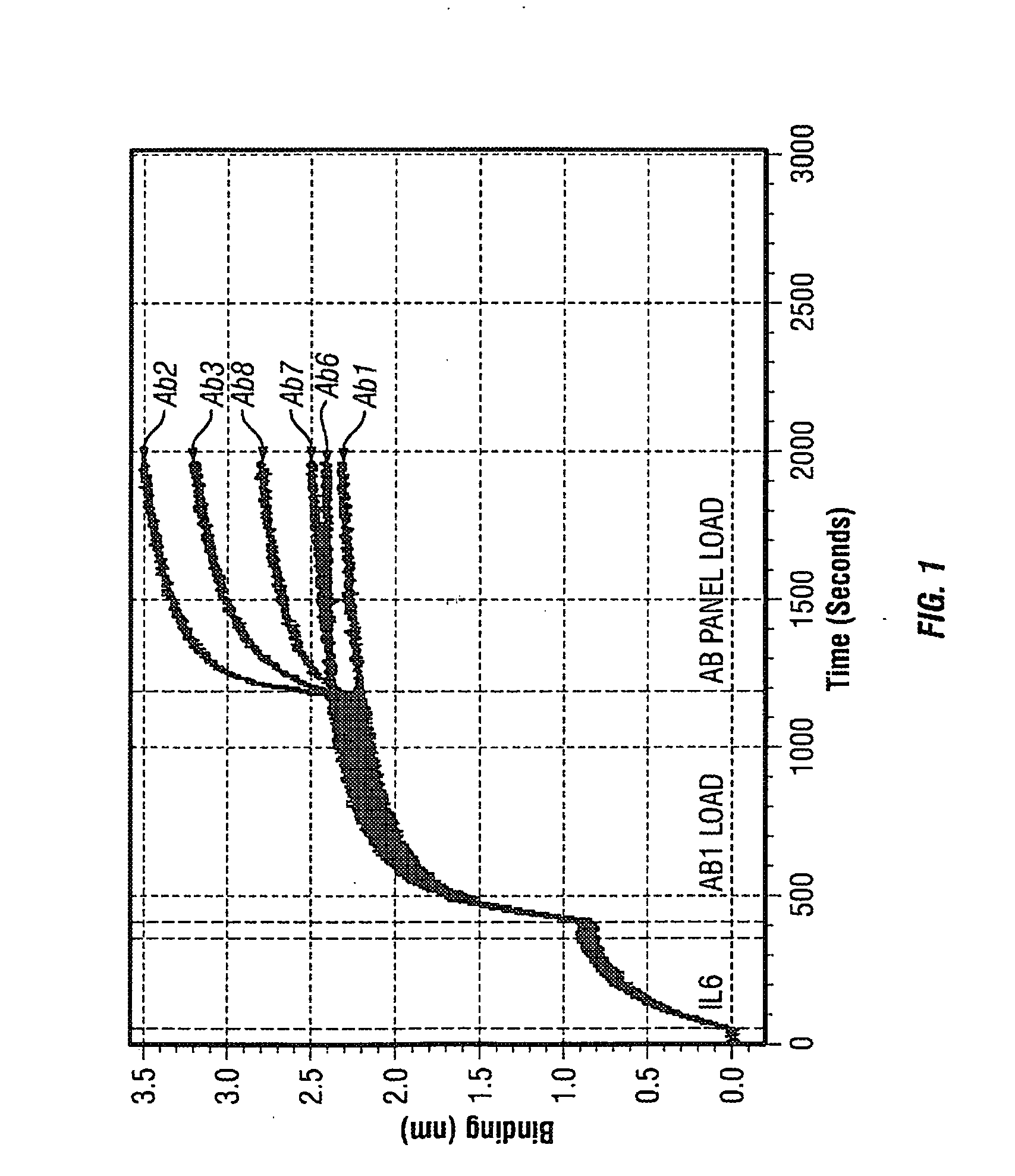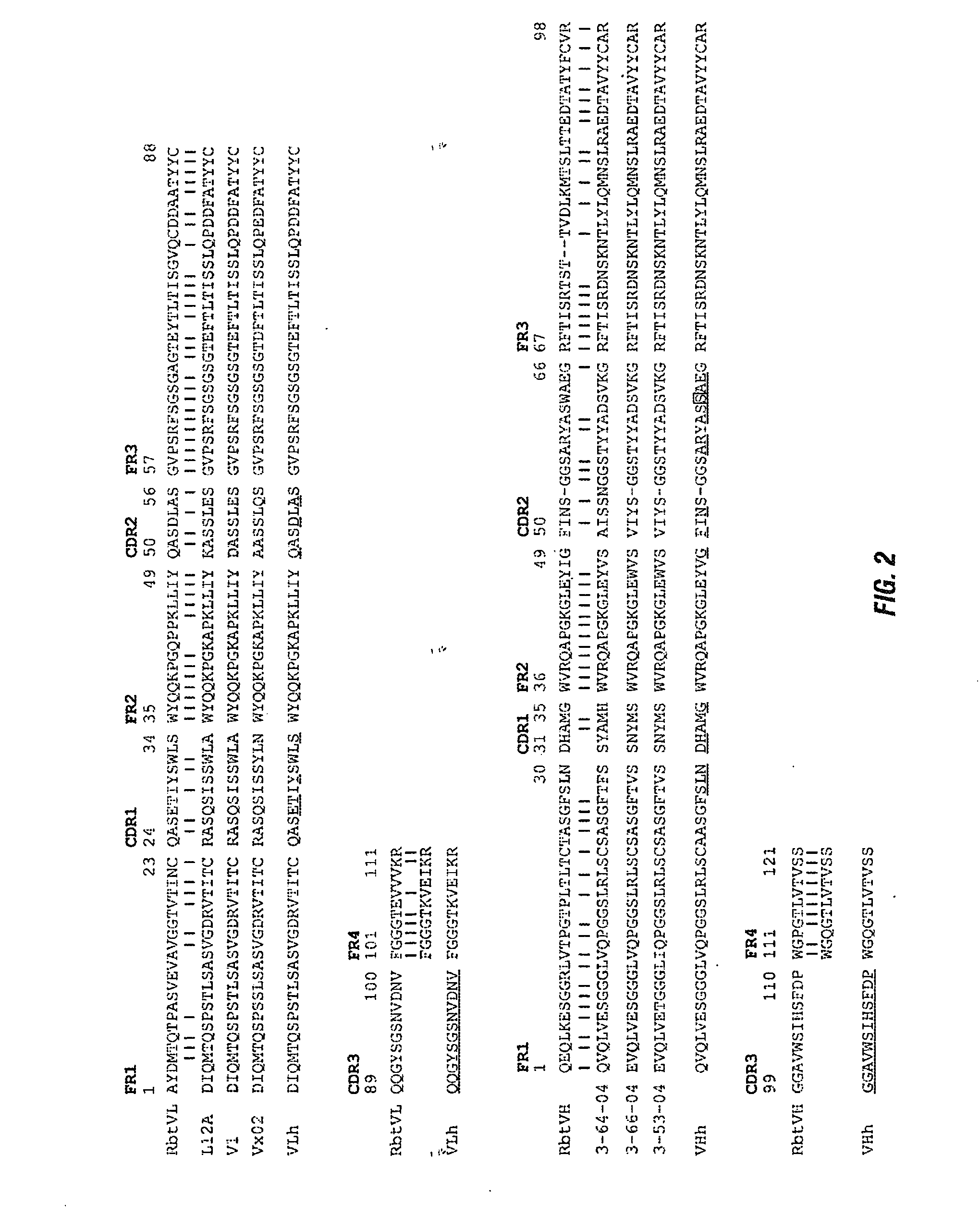Antibodies to il-6 and use thereof
- Summary
- Abstract
- Description
- Claims
- Application Information
AI Technical Summary
Benefits of technology
Problems solved by technology
Method used
Image
Examples
Example
Example 1
Production of Enriched Antigen-Specific B Cell Antibody Culture
[0769]Panels of antibodies are derived by immunizing traditional antibody host animals to exploit the native immune response to a target antigen of interest. Typically, the host used for immunization is a rabbit or other host that produces antibodies using a similar maturation process and provides for a population of antigen-specific B cells producing antibodies of comparable diversity, e.g., epitopic diversity. The initial antigen immunization can be conducted using complete Freund's adjuvant (CFA), and the subsequent boosts effected with incomplete adjuvant. At about 50-60 days after immunization, preferably at day 55, antibody titers are tested, and the Antibody Selection (ABS) process is initiated if appropriate titers are established. The two key criteria for ABS initiation are potent antigen recognition and function-modifying activity in the polyclonal sera.
[0770]At the time positive antibody titers are es...
Example
Example 2
Production of Clonal, Antigen-Specific B Cell-Containing Culture
[0772]Enriched B cells produced according to Example 1 are then plated at varying cell densities per well in a 96 well microtiter plate. Generally, this is at 50, 100, 250, or 500 cells per well with 10 plates per group. The media is supplemented with 4% activated rabbit T cell conditioned media along with 50K frozen irradiated EL4B feeder cells. These cultures are left undisturbed for 5-7 days at which time supernatant-containing secreted antibody is collected and evaluated for target properties in a separate assay setting. The remaining supernatant is left intact, and the plate is frozen at −70° C. Under these conditions, the culture process typically results in wells containing a mixed cell population that comprises a clonal population of antigen-specific B cells, i.e., a single well will only contain a single monoclonal antibody specific to the desired antigen.
Example
Example 3
Screening of Antibody Supernatants for Monoclonal Antibody of Desired Specificity and / or Functional Properties
[0773]Antibody-containing supernatants derived from the well containing a clonal antigen-specific B cell population produced according to Example 2 are initially screened for antigen recognition using ELISA methods. This includes selective antigen immobilization (e.g., biotinylated antigen capture by streptavidin coated plate), non-specific antigen plate coating, or alternatively, through an antigen build-up strategy (e.g., selective antigen capture followed by binding partner addition to generate a heteromeric protein-antigen complex). Antigen-positive well supernatants are then optionally tested in a function-modifying assay that is strictly dependant on the ligand. One such example is an in vitro protein-protein interaction assay that recreates the natural interaction of the antigen ligand with recombinant receptor protein. Alternatively, a cell-based response th...
PUM
| Property | Measurement | Unit |
|---|---|---|
| Fraction | aaaaa | aaaaa |
| Fraction | aaaaa | aaaaa |
| Fraction | aaaaa | aaaaa |
Abstract
Description
Claims
Application Information
 Login to View More
Login to View More - R&D
- Intellectual Property
- Life Sciences
- Materials
- Tech Scout
- Unparalleled Data Quality
- Higher Quality Content
- 60% Fewer Hallucinations
Browse by: Latest US Patents, China's latest patents, Technical Efficacy Thesaurus, Application Domain, Technology Topic, Popular Technical Reports.
© 2025 PatSnap. All rights reserved.Legal|Privacy policy|Modern Slavery Act Transparency Statement|Sitemap|About US| Contact US: help@patsnap.com



